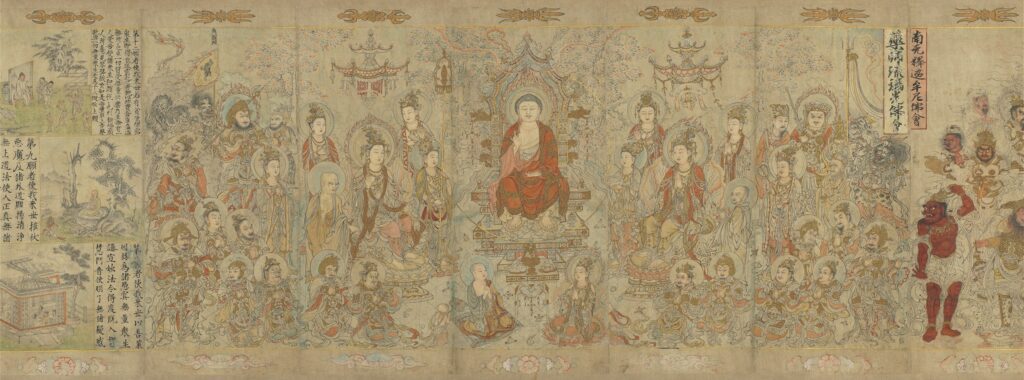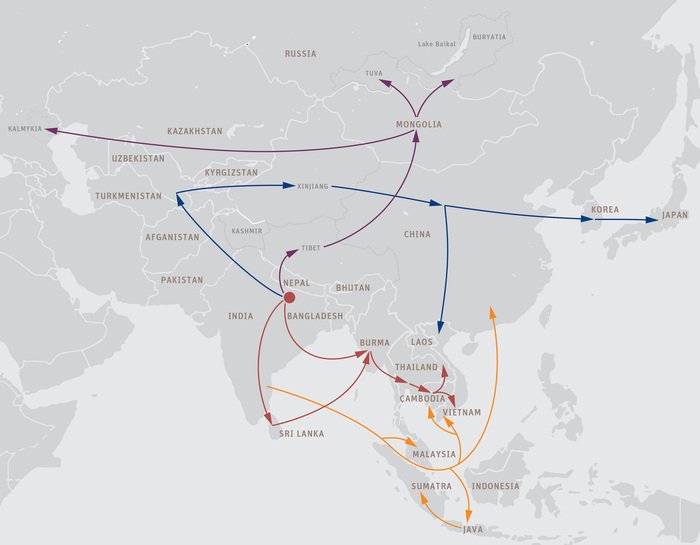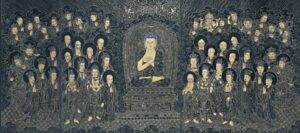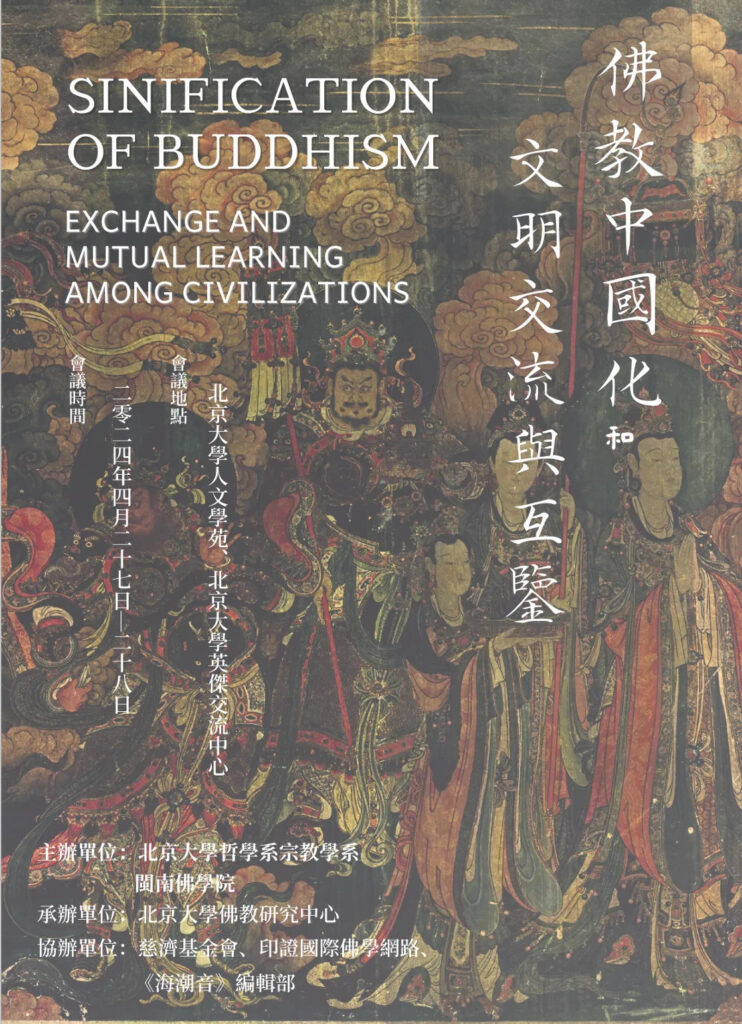佛教中國化和文明交流與互鑒學術研討會
Sinification of Buddhism – Exchange and Mutual Learning among Civilizations

27-28 April, 2024
Host: Centre for Buddhist Studies, Peking University, Beijing
Co-Host: Buddhist College of Minnan, South Putuo, Xiamen
This event is supported by the Yin-Cheng Network for Buddhist Studies
What role has Buddhism played in global and Asian history? How does it connect states from different parts of the world as a vehicle of culture? This conference will explore the plurality of Buddhist traditions and their alternative patterns of co-existence, with a special focus on Asian, especially Chinese, Buddhism.
Buddhism was and remains a major religion across Asia. Since the early medieval period, Buddhism has been a common thread among India, China, Japan, and other countries, providing numerous opportunities for cultural exchange and interaction over a long period of time. By adopting a pan-Asian perspective, we can view Buddhism not as a foreign religion imported into a particular region, but as an integral part of a broader area over an extended period.
Through the experiences of Buddhist civilizations, both past and present, we can observe the equal, if not greater, significance of collaboration, exchange, and mutual learning compared to conflicts. Even during times of tension caused by struggles between political powers, various Buddhist agencies played a role in coordinating and balancing competing authorities. This leads us to consider the concept of a ‘Buddhist Civilization’, which presents a unique paradigm in contrast to Huntington’s assumption of fundamental conflicts between cultural, ideological, and political entities. Articulating this concept more clearly will offer new insights not only into our past, but also into our present and future.
The conference will cover a range of topics related to historical, political, social, philosophical, and iconographical issues in various Asian countries. Seventy-five scholars will present their advanced research under two main themes: I. Buddhism and Exchange among Civilizations; II. Sinification of Buddhism: Texts, Ideas, and History.

I. Buddhism and Exchange among Civilizations
The first group, consisting of eight panels, will mainly focus on modern case studies. These episodes are part of a process that continues to shape our world. Buddhist monks from Asia, Europe, and Africa have worked to build a ‘Global Network of Buddhism’ from the late imperial to modern eras (I.a). Papers on Master Fa Fang, Master Zhaokong (Ignatius Trebitsch Lincold), and monastic education in African Buddhist seminaries illustrate the long-term efforts of determined individuals and institutions.
Meanwhile, scholars from various backgrounds, both clerical and secular, studied Buddhism with their own agendas in mind. For instance, the historian Johannes Prip-Møller contributed to interfaith dialogue through the study of Chinese Buddhist architecture. Karl Ludvig Reichelt, a Norwegian missionary, adopted and propagated Chinese Buddhist meditation to Lutheran communities. Raghu Vira and Lokesh Chandra used Buddhism to shape a common historical memory and form a national identity in modern India. The Essential Records of Japanese Buddhists’ Visit to China (Nihon bukkyoto houka yoroku) describes how members of this delegation perceived the history and current state of Chinese Buddhism, compared to their own sectarian beliefs. These cases demonstrate the ongoing ‘Mutual Learning among Civilizations’ (I.b) through Buddhism.
The topic of ‘Social Engagement of Buddhism’ (I.c) has gained significant attention in recent times, particularly with the emergence of Humanistic Buddhism, monastic communities, and charities in mainland China and Taiwan. Two panelists discuss innovations in Buddhist education during late imperial China, while others examine the Tzu Chi Foundation. The question is raised whether Cheng Yen’s slogan ‘Eat Vegetarian and Save the World’ implies a new Buddhist eschatology. How does Tzu Chi spread Master Cheng Yen’s vision through charitable networks worldwide, with a particular focus on women?
The panel “Reflections on the Modernisation of Buddhism” (I.d) includes general discussions on the problems that Asian Buddhism has encountered in the process of global modernization. In one way or another, Buddhist institutions have had to adapt to cooperate with secular governance over religious authorities. Among all the attempts to modernize Buddhism in Asia, Taixu is a unique case. Contributions to the panel “Studies of Taixu: Research Frontiers’ (I.e) looks at various aspects of his lifelong activities, including his travels in South Asia, his participation in international Buddhist associations, and his worldviews.
“The Sinification of Buddhism: Cultural Innovations” (I.g)and “Contemporary Practice” (I.f) form duo panels. The former provides an overview of institutional and cultural innovations in the history of Chinese Buddhism since the time of Lushan Huiyuan, with particular attention to popular ideologies such as Pure Land, derived from its Sukhāvatī prototype. Although Buddhism in twentieth-century China was once radically interrupted, this process of acculturation and innovation has never ceased. The papers in the Contemporary Practice panel offer us new insights into the Buddhist origins of the Lantern Festival, Buddhist attitudes to work in a socialist state, and the many resolutions to adapt Buddhist practices to a secular Chinese society.
Another relevant but distinct theme of modern Chinese Buddhism is embodied in ‘Interactions between modern academics and ecclesiastical circles’ (I.h). By looking at the founding of the Journal of Modern Buddhology, three editions of the Encyclopedia of Buddhism, and historiography in Taiwan during the Japanese colonial period, this panel will explore the modernization of Chinese Buddhism through academic writing.
II. The Sinification of Buddhism: Texts, Ideas and History
Mirroring the modern and early modern cases, the papers in this second theme look further back into the historical past, tracing sources for further theorization. Clearly, translation and commentary practices based on translation cannot simply be ignored in order to understand some of the key turning points in the process of Buddhist Sinification. “The Dissemination and Interpretation of Buddhism across Borders” (II.a) combines a range of topics and approaches: from copying habits to grammatical analysis, from translations of the earliest scriptures to exegesis on the idea of scripture (sūtra) itself. On a microscopic scale, these case studies bear witness to the complex process by which Buddhist textual traditions were woven into Chinese literary culture.
Visual and ritual practices often foreshadow the arrival of Buddhism as a whole. The panel on ‘Image, Ritual and Belief’ (II.b) draws on a wide range of sources, including Vairocana images from Khotan, a thematic type of vajra tangka preserved in the Yonghe Palace Collection, and fusions of Buddhist and non-Buddhist rites in local practices.
The challenge of the cultural other is always an opportunity for exchange, negotiation and fusion. The body and filial piety, as central pillars of traditional Chinese ideology, will be the main themes in ‘Buddhism and Chinese Traditional Culture’ (II.c). Meanwhile, the special Chinese sense of history has made Buddhism “Chinese” through historical and hagiographical writing. In “History and Ideas of Medieval Buddhism” (II.f), scholars will look at the formation of Buddhist annals in China through newly discovered manuscripts, analyze how Avalokiteśvara is incorporated into the belief of Prince Moonlight through the creation of new scriptures, and how travelogues reconstructed Buddhist geography.
The elaboration and popularization of the doctrine of Tathāgatagarbha and Buddha-nature is one of the crucial points in the Sinification of Buddhist philosophy. “Buddhist Exegesis: Indigenous Developments” (II.d) brings together studies of the development and debate around the family of ideas in the early Tang dynasty, the Three-Level Teaching, and Fazang’s commentaries.
“New Perspectives of Buddhist Philology” (II.e) relates important scriptures to specific time and space through philological discoveries, from the renowned Dunhuang collection to the Tenri Central Library in Japan. In addition, the papers in the panel on ‘Textual Interpretation and Thought Exploration’ (II.g) rethink the interpretation of scriptures through the lens of specific textual activities and material culture.
The balance between knowledge and action, teaching and meditation has been central to all Buddhist traditions. The dynamics of ‘Interaction between Chan and Jiao’ (II.h) are manifested from the early Chan masters of the Northern dynasties, through Tankuang’s ‘Twenty-Two Dialogues on Mahāyāna’ in response to Moheyan’s famous speech, Fazang’s views on the Sudden Teaching, to the teachings of Caodong as inspired by the Sutra of Perfect Enlightenment.
The final panel on ‘Norms of Behaviour and Ideology’ (II.i) focuses on Buddhist precepts and rules of argument. These advanced studies deal with puzzling problems such as the transformation of the bodhisattva precepts, the formation of the Vinaya Piṭaka, and the way in which unknown meanings can be conveyed by reasoning.

Contents
I. Buddhism and Exchange among Civilizations
I.a Global Network of Modern Buddhism
- Chen, Ming: Buddhist Exchange between China, Myanmar and India in the Modern Period: Based on Chinese and Foreign Archives
- Ji, Yun: Chinese Buddhism in Singapore: A Case Study of the Globalization of Buddhism
- Hu, Yonghui: Attempts at Universalization of Buddhism in Modern China
- Shao, Jiade: Master Zhaokong and His International Interactions among Modern Monks
I.b Exchange and Mutual Learning among Civilizations
- Guggenmos, Esther Maria: When Christians become inspired by Chinese Buddhist meditation – Karl Ludvig Reichlt’s (1877 – 1952) Perception, Adoption, and Dissemination of Chinese Buddhism
- Orsborn, Matthew: The African Buddhist Seminary: An Experiment in Cross-Cultural Monastic Education
- Chen, Jidong: The Japanese Buddhists’Perceptions of Modern Chinese Buddhism: Focusing on Essential Records of Japanese Buddhists’ Visit to China (Nihon bukkyoto houka yoroku [1928])
- Bian, Huiyuan: Cultural Construction and National Identity in Modern India: The Buddhist Path of “Indian Xuanzang”
- Zhang, Hanjing: The fusion and coexistence ofBuddhismand Hinduism in South Asia
I.c Social Engagement of Buddhism
- DeVido, Elise Anne: Master Cheng Yen’s 大哉教育 ‘The Great Lesson of Our Times:’ Eat Vegetarian and Save the World: A New Buddhist Eschatology?
- Travagnin, Stefania: Career and Legagy of the Monk Bianneng 遍能(1906-1997) Negotiating Tradition and Innovation in Twentieth-century Sichuan Buddhism
- Zhang, Kai: The Modern Development of Buddhist Charity in China: A Case Study of Ningbo Buddhist Orphanage
- Li, Yuzhen: International Stronghold Established by Female Members of Tzu Chi: Silicon Valley, Indonesia, and Mozambique
- Shi, Hongjin: A Survey on Establishing Buddhist College in Late Qing Dynasty
I.d Reflections on the Modernization of Buddhism
- He, Rong:Chinese Buddhism as the Culture Mechanism of Chinese-Style of Modernization
- Lai, Yueshan: On Several Basic Structures of Modern Chinese Buddhist Development
- Zhang, Xuesong:On the Ideal of “Virtuous Rule” Constructed by Modern Chinese Buddhism: Reflections on the Buddhist and Cultural Theories Promoted by Modern Chinese Buddhism from the Perspective of Diffuse Religion
- Li, Haitao: The Transformation of Modern East Asian Buddhism and Its Consciousness of Problems
I.e Studies of Taixu: Research Frontiers
- Li, Can: A Note on Historical Records of Taixu Preserved in Sri Lanka
- Gan, Qinxin: Research on Master Taixu and Modern Korean Buddhism
- Yan, Lei: Buddhist Pure Land and the World: A Study on the Travel Notes of Taixu
- Shi Menyuan: Taixu and World Buddhist Federation
I.f Sinification of Buddhism: Contemporary Practice
- Sun, Guozhu: Publicization, Humanization and Knowledge transformation: A Study on the Practical Path of Sinicization of religion
- Liu, Chang: The Transformation of the Buddhist View of Labor and the Practice of Contemporary Adaptation of Buddhism to the Chinese Context
- Zhao, Wen: The Prātihārakapakṣa in Indian Buddhism and the Lantern Festival
- Shi, Fayuan: Sinification of Buddhism in the New Era: Duties and Value
I.g Sinification of Buddhism: Cultural Innovations
- Lin, Xiao: Integration and Innovation: The Interaction between Buddhism and Chinese Civilization in the Sinicization Process
- Li, Xiang: The Origin and the Development of the Concept of Pure Land: From a Perspective of Buddhism in Chinese Context
- Shi, Changxing: Lushan Huiyuan’s Practice Contributed to the Sinification of Buddhism, with Theory and Institutional Construction in Focus
- Shi, Gufu: The Spirit of hehe in Traditioal Culture and the Sinification of Buddhism
I.h Interactions Between Modern Academic and Ecclesiastical Circles
- Wang, Lina: An Overview of Chan Studies in America (1990-2020’s)
- Wang, Jia: A Study on the Founding Background and Development Process of the Journal of Modern Buddhism
- Fan, Wenli:A Survey of Three Compilations of Buddhist Encyclopedias in China from 1950s to 2000s
- He, Songwei: The History of Buddhism in Taiwan during the Japanese Colonial Period: A Review of the Scholarship since the 1980s
II. Sinification of Buddhism: Texts. Ideas, and History
II.a The Dissemination and Interpretation of Buddhism cross Borders
- Zhao, You: A Note on the Jifa in Chinese Buddhist Writing
- Guo, Wei: The Application and Evaluation of Saṭ-samāsāḥ in the Annotations of the Xingshi Chao
- Lin, Jian: Interpreting “Sūtra”: A Dissection of the Canon View during the Six Dynasties
- Sun, Haike: Comparison and Inference of the Earliest Chinese Translations of the Dhammapada
- Pang, Boyang: The Study On the Translation of Zhong Shi Fen A Pi Tan
II.b Image, Ritual, and Faith
- Chen, Suyu : A Study of the Images of Vairocana in Khotan
- Huang, Lele: The Evolution of Avalokiteśvara’s Iconography in Ancient India
- Wang, Shuai: Research on the Tangka of Ju Shi Shan Vajra in the Yonghe Palace Collection
- Wu, Xiaojie: A preliminary study on the ways of integrating Pu’an Beliefs into the Anlong Xietu Rituals
- Neng Ren: The Lost Goddess: Dissemination and Transformation of the Faith in Lakṣmī in Chinese Buddhism
IIc. Buddhism and Chinese Traditional Culture
- Imre Hamar: The Buddhist Interpretation of the Confucianist Concept of Family: Filial Piety as Universal Compassion
- Han, Chuanqiang: Buddhist view of Confucian Scholars in the late Ming Dynasty: a“slice”of the Sinicization of Buddhism
- Chen, Chao : Early Chinese Buddhist Conceptual Constructions of Filial Piety and the Study of Xiaoing–Centered on Yudaolun
- Shi, Xingpu : The Medical Thoughts in the Foshuo zhibing jing: On the Fusion of Buddhist Medicine and Traditional Chinese Medical Culture
II.d Buddhist Exegesis: Indigenous Developments
- Fu, Xinyi: The Innate Seed of Non-Affliction: A Key Point of Debate on the Buddha Nature in Early Tang
- Zhang, Wenliang: Buddha Nature in the Three-Stage Teaching
- Yang, Yufei: The Development of Tathāgatagarbha-pratītyasamutpāda Thought in Chinese Buddhism
- Li, Haijie: From “Non-Separation” to “Mutual Inclusion”——Fazang’s Thought in the Commentary on the Awakening of Faith in Mahāyāna
II.e New Perspectives of Buddhist Philology
- Ding Yuan: Examination of the Monk Huiding from Shaoxing in Southern Song Dynasty and his Records of Manifestions through the Diamond Sutra
- Ze Hui: A philological investigation of Daosui’s biographical materials
- Yang, Zurong: Research of the Commentaries of the Vimalakirtinirdesa Discovered from Dunhuang and Turfan
- Zhang, Meiqiao: The manuscripts of the *Mahāprajñāpāramitāsūtra transcribed from the Fuzhou Canon (Kaiyuansi edition) in the Tenri Central Library
II.f History and Ideas of Medieval Buddhism
- Sun, Qi: The Early Buddhist Stone Pillar with Fumu enzhong jing : A Study of the Stone Pillar Installed in Lin County in the Twenty-Fifth year of Kaiyuan
- Wu, Shaowei: Texts on the Belief in Prince Moonlight and Avalokiteshvara in the Medieval Period
- Chen, Zhiyuan: The Formation of Buddhist Annals in the Context of Buddho-Daoist Polemics—Reading the Newly Discovered Manuscript Chuanfa Ji (The Records of Dharma Transmission) Preserved in Ishiyamadera
- Yang, Jianxiao: Geographical Concepts and Practices of Buddhist Monks in Wei Jin Southern and Northern Dynasties
II.g Textual Interpretation and Explorations of Thoughts
- Wang, Xuemei: Buddhism and Method: Tsung-mi’s “Yuan Ren Lun” and Its Reasoning model
- Fang, Yuan: A Study of Yongming Yanshou’s The Images of the Twenty Four Manifestations of Guanyin, with Further Notes on the Influence of the Wutai Mountain on Buddhism in Wu Region
- Ping, Yanhong: A New Perspective on Huayan Studies: Based on the Restoration and Research of Wŏnjong munnyu 圓宗文類 compiled by Ŭich’ŏn 義天
- Li, Mingjia: The Interpretation on the Chinese edition Diamond Sutra from Japanese Gozan Monks’ Shoumono: A Case Study of the Edo Woodblock Edition “Konjushou”
II.h Interactions between Chan and Jiao
- Li, Zijie: The Early Chan Masters in the Northern dynasties and the Dilun
- Yang, Hao: A Comparative Study of the Buddhist Thoughts in Tankuang’s “The Twenty-Two Dialogues on Mahayana” and Heshang Moheyan’s “The Judgement on Sudden Awakening Being the True Principle of Mahāyāna”
- Du, Jingting: The Teaching without Speech: Pedagogies of Chan as Seen in Fazang’s Examination of the Sudden Teaching
- Kong, Yan: The Perspective on Delusion and Enlightenment in the Sutra of Perfect Enlightenment and Its Impact on the Teachings of Caodong Tradition in the Song Dynasty
II.i Norms of Behavior and Ideology
- Xia, Demei: The Brahma Net -linked bodhisattva precepts or Yoga-linked bodhisattva precepts——The Historical Roots and Era Values of Two Major Decisions in the History of Bodhisattva Precepts
- Wang, Dawei: Regulations on Dietary among Buddhists in Sui-Tang Dynasties
- Li, Wei: A Study of the Ujjhāpanakasikkhāpadaṃ of the Pācittiya
- Chen, Shuai: How to Transmit the Meaning Unknown to the Opponent: The Six Causes and the Interpretation of the Course of Argument in Chinese Buddhist Logic












